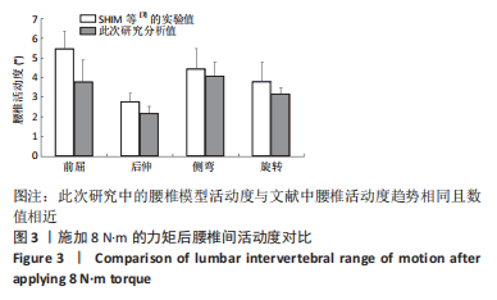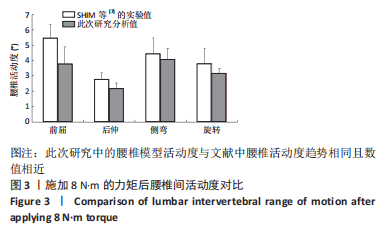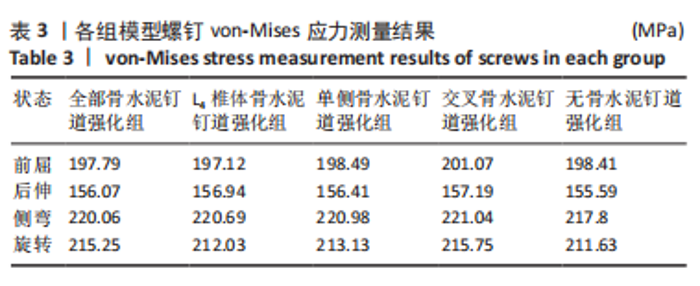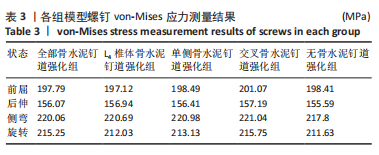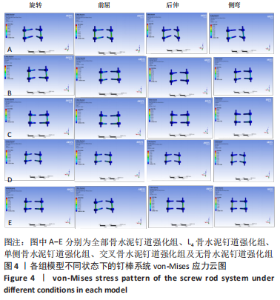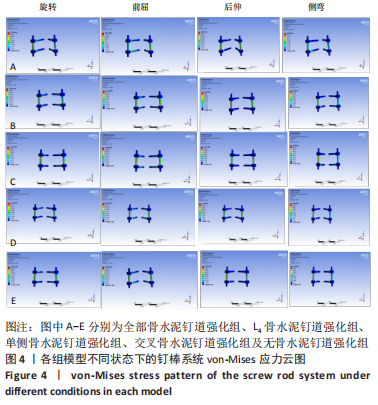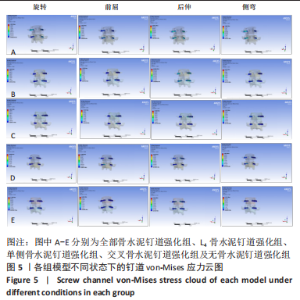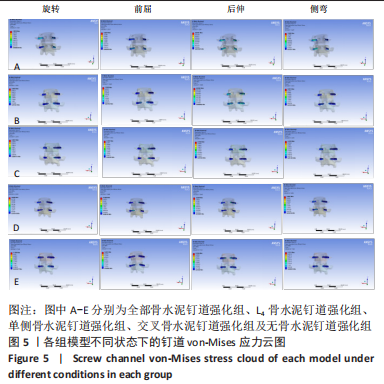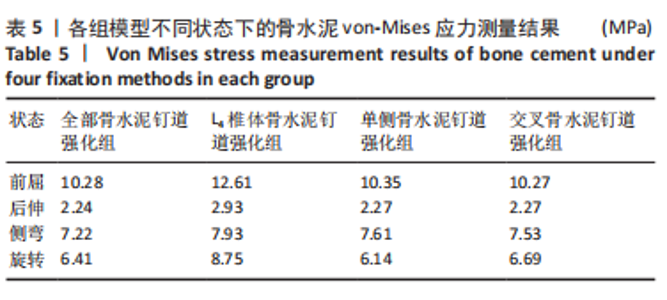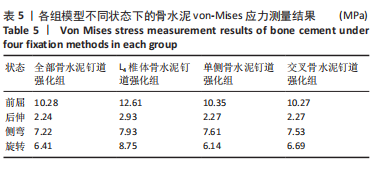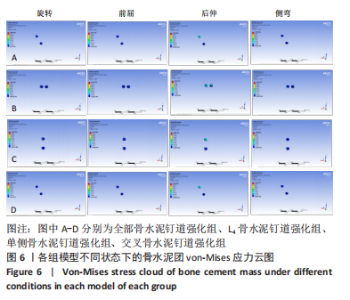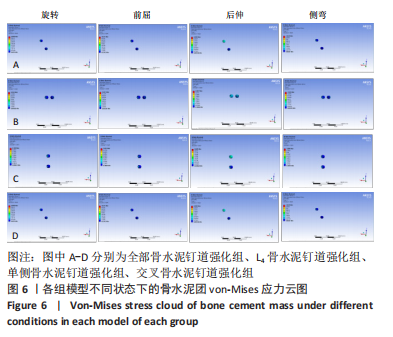Chinese Journal of Tissue Engineering Research ›› 2023, Vol. 27 ›› Issue (21): 3287-3292.doi: 10.12307/2023.456
Previous Articles Next Articles
Biomechanical characteristics of bone cement augmentation internal fixation system in patients with osteoporosis
Nie Wenzhong, Jiang Guangpu, Han Xiao, Xu Wei
- College of Mechanical Engineering, Shanghai Institute of Technology, Shanghai 201418, China
-
Received:2022-05-05Accepted:2022-07-14Online:2023-07-28Published:2022-11-23 -
Contact:Nie Wenzhong, MD, Associate professor, College of Mechanical Engineering, Shanghai Institute of Technology, Shanghai 201418, China -
About author:Nie Wenzhong, MD, Associate professor, College of Mechanical Engineering, Shanghai Institute of Technology, Shanghai 201418, China
CLC Number:
Cite this article
Nie Wenzhong, Jiang Guangpu, Han Xiao, Xu Wei. Biomechanical characteristics of bone cement augmentation internal fixation system in patients with osteoporosis[J]. Chinese Journal of Tissue Engineering Research, 2023, 27(21): 3287-3292.
share this article
Add to citation manager EndNote|Reference Manager|ProCite|BibTeX|RefWorks
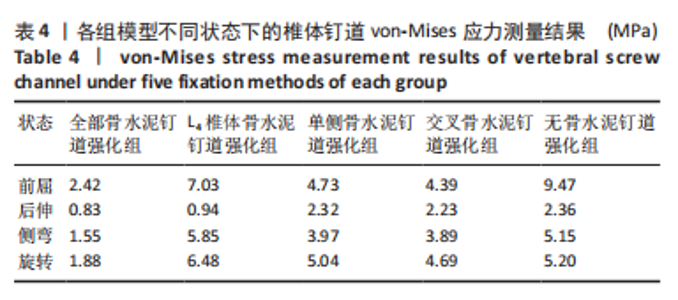
2.3 各组模型椎体钉道的von-Mises应力 5组模型不同状态下的钉道von-Mises应力测量结果见表4。将无骨水泥钉道固定组作为对照组,发现经过骨水泥强化钉道的von-Mises应力在整体上小于对照组,其中较为显著的为全部骨水泥钉道强化组,在前屈时钉道von-Mises应力下降了74.4%,后伸时下降了64.6%,侧弯时下降了66.9%,旋转时下降63.8%,钉道von-Mises应力下降十分明显;与全部骨水泥强化组效果相近的是交叉骨水泥强化组,在前屈时钉道von-Mises应力下降了53.7%,后伸时下降较少,为5.5%,侧弯时下降了24.6%,旋转时下降了9.7%;单侧骨水泥固定组的钉道von-Mises应力下降幅度次于交叉骨水泥固定组,L4椎体骨水泥钉道强化组对于钉道von-Mises应力的下降效果不明显,且在侧弯与旋转时钉道von-Mises应力超过对照组。5组模型不同状态下的钉道von-Mises应力云图如图5所示。"
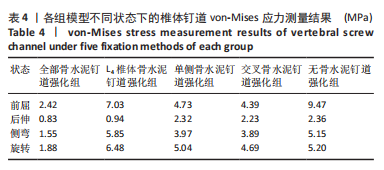
| [1] LANGDAHL BL. Overview of treatment approaches to osteoporosis. BRit J Pharmacol. 2021;178(9):1891-1906. [2] DING H, HAI Y, LIU Y, et al. Cortical Trajectory Fixation Versus Traditional Pedicle-Screw Fixation in the Treatment of Lumbar Degenerative Patients with Osteoporosis: A Prospective Randomized Controlled Trial. Clin Interv Aging. 2022;17:175. [3] HUANG D, YING J, XU D, et al. Comparison of percutaneous kyphoplasty with or without pedicle screw fixation in osteoporotic thoracolumbar vertebral fractures: a Retrospective Study. Dis Markers. 2021;2021:4745853. [4] KANIS JA, COOPER C, RIZZOLI R, et al. European guidance for the diagnosis and management of osteoporosis in postmenopausal women. Osteoporosis Int. 2019;30(1):3-44. [5] WANG Y, YANG L, LI C, et al. The Biomechanical Properties of Cement-Augmented Pedicle Screws for Osteoporotic Spines. Glob Spine J. 2022;12(2):323-332. [6] PINTAR FA, YOGANANDAN N, MYERS T, et al. Biomechanical properties of human lumbar spine ligaments. J Biomech. 1992;25(11):1351-1356. [7] SHIM CS, PARK S W, LEE SH, et al. Biomechanical evaluation of an interspinous stabilizing device, Locker. Spine J. 2008;33(22):E820-E827. [8] YANG SC, LIU PH, TU YK. Pullout evaluation of sawbone experiment in different types of pedicle screws combined with bone cement augmentation for severe osteoporotic spine. Acta Bioeng Biomech. 2018;20(2):55-64. [9] TANG YC, GUO HZ, GUO DQ, et al. Effect and potential risks of using multilevel cement-augmented pedicle screw fixation in osteoporotic spine with lumbar degenerative disease. BMC Musculoskel Dis. 2020; 21(1):274. [10] CHEVALIER Y, MATSUURA M, KRÜGER S, et al. The effect of cement augmentation on pedicle screw fixation under various load cases: results from a combined experimental, micro-CT, and micro-finite element analysis. Bone Joint Res. 2021;10(12):797-806. [11] HUANG H, ZHANG K, CHENG X, et al. Finite Element Analysis of Lumbar Interbody Fusion with Stent-Bone Granule-Absorbable Bone Cement. Int J Spine Surg. 2021:E184-E188. [12] OSHTORY R, HARRIS JA, PATEL PD, et al. Lumbar intervertebral spacer with cement augmentation of endplates and integrated screws as a fixation device in an osteoporotic model: an in vitro kinematic and load-to-failure study. Int J Spine Surg. 2021;15(2):324-333. [13] XIAO Q, ZHAO Y, QU Z, et al. Association Between Bone Cement Augmentation and New Vertebral Fractures in Patients with Osteoporotic Vertebral Compression Fractures: A Systematic Review and Meta-Analysis. World Neurosurg. 2021;153:98-108.e3. [14] TAN JS, SINGH S, ZHU QA, et al. The effect of cement augmentation and extension of posterior instrumentation on stabilization and adjacent level effects in the elderly spine. Spine J. 2008;33(25):2728-2740. [15] GUO HZ, TANG YC, GUO DQ, et al. The cement leakage in cement-augmented pedicle screw instrumentation in degenerative lumbosacral diseases: a retrospective analysis of 202 cases and 950 augmented pedicle screws. Eur Spine J. 2019;28(7):1661-1669. [16] WILKES R, MACKINNON J, THOMAS W. Neurological deterioration after cement injection into a vertebral body. J Bone Joint Surg Br. 1994;76(1): 155-155. [17] MILLS S, PIZONES J, RUEDA LRM, et al. Cardiac Cement Embolism After Thoracic Kyphoplasty: Successful Conservative Treatment With 4-Year Follow-Up. Int J Spine Surg. 2022;16(1):27-32. [18] EL SAMAN A, MEIER S, SANDER A, et al. Reduced loosening rate and loss of correction following posterior stabilization with or without PMMA augmentation of pedicle screws in vertebral fractures in the elderly. Eur J Trauma Emerg Surg. 2013;39(5):455-460. [19] KARLIN LI, MCCLUNG A, JOHNSTON CE, et al. The growth-friendly surgical treatment of scoliosis in children with osteogenesis imperfecta using distraction-based instrumentation. Spine Deformity. 2021;9(1): 263-274. [20] 王鹏,王健,胡勇,等.下腰椎融合术后路单, 双侧椎弓根固定的有限元比较研究[J].中国临床解剖学杂志,2016,34(3):331-337. [21] HÖCH A, SCHIMPF R, HAMMER N, et al. Biomechanical analysis of stiffness and fracture displacement after using PMMA-augmented sacroiliac screw fixation for sacrum fractures. Biomed Tech (Berl). 2017; 62(4):421-428. [22] LIU YY, XIAO J, YIN X, et al. Clinical efficacy of bone cement-injectable cannulated pedicle screw short segment fixation for lumbar spondylolisthesis with osteoporosise. Sci Rep. 2020;10(1):3929. [23] KANNO H, ONODA Y, HASHIMOTO K, et al. Innovation of Surgical Techniques for Screw Fixation in Patients with Osteoporotic Spine. J Clin Med. 2022;11(9):2577. [24] LIU Z, LIANG H, SUN W, et al. Risk factors for local bone destruction progression in palliative percutaneous vertebroplasty for vertebral metastases and the significance of bone cement filling rates. Pain Physician. 2021;24(1):E101-e109. [25] FAN J, LIU T, DONG X, et al. Effect of Zoledronic Acid on the Vertebral Body Bone Mineral Density After Instrumented Intervertebral Fusion in Postmenopausal Women With Osteoporosis. Glob Spine J. 2021: 21925682211027833. [26] ZHANG W, LI L, ZHOU X, et al. Concurrent Treatment with Vitamin K2 and D3 on Spine Fusion in Patients with Osteoporosis-Associated Lumbar Degenerative Disorders. Spine J. 2022;47(4):352-360. [27] TANI S, ISHIKAWA K, KUDO Y, et al. The effect of denosumab on pedicle screw fixation: a prospective 2-year longitudinal study using finite element analysis. J Orthop Surg Res. 2021;16(1):219. [28] ZHANG Y, JIANG Y, ZOU D, et al. Therapeutics for enhancement of spinal fusion: A mini review. J Orthop Transl. 2021;31:73-79. [29] WANG Z, ZHUANG C, CHEN W, et al. The Effect of Daily Teriparatide versus One-Time Annually Zoledronic Acid Administration After Transforaminal Lumbar Interbody Fusion in Osteoporotic Patients. Clin Interv Aging. 2021;16:1789. [30] OTSUKI B, FUJIBAYASHI S, TANIDA S, et al. Possible association of pedicle screw diameter on pseudoarthrosis rate after transforaminal lumbar interbody fusion. World Neurosurg. 2021;150:e155-e161. [31] SHIBUYA Y, KATSUMI K, OHASHI M, et al. Effect of adjuvant therapy with teriparatide in patients with thoracolumbar osteoporotic vertebral fractures who underwent vertebroplasty with posterior spinal fusion. Sci Rep-UK. 2022;12(1):1-8. [32] SARDAR Z M, COURY JR, CERPA M, et al. Best practice guidelines for assessment and management of osteoporosis in adult patients undergoing elective spinal reconstruction. Spine J. 2022;47(2):128-135. [33] HYAKKAN R, KANAYAMA M, TAKAHATA M, et al. Bone Metabolism in the Healing Process of Lumbar Interbody Fusion: Temporal Changes of Bone Turnover Markers. Spine J. 2021;46(23):1645-1652. [34] 李黎,廖怀章.中药二仙汤治疗骨质疏松症的临床效果[J].临床合理用药杂志,2021,14(22):109-110. [35] 张虎林,汪小敏,曹林忠,等.二仙汤联合椎弓根钉道骨水泥强化应用于骨质疏松伴腰椎管狭窄症的临床研究[J].时珍国医国药, 2020,31(8):1902-1904. |
| [1] | Jiang Xiaocheng, Shi Lu, Wang Yinbin, Li Qiujiang, Xi Chuangzhen, Ma Zefeng, Cai Lijun. Systematical evaluation of bone fusion rate after interbody fusion in patients with osteoporosis and lumbar degenerative disease treated with teriparatide [J]. Chinese Journal of Tissue Engineering Research, 2023, 27(9): 1427-1433. |
| [2] | Zhong Yizheng, Huang Peizhen, Cai Qunbin, Zheng Liqin, He Xingpeng, Dong Hang. Microstructural indexes that determine the trabecular bone maximum stress of micro-finite element models [J]. Chinese Journal of Tissue Engineering Research, 2023, 27(9): 1313-1318. |
| [3] | Li Xiaomin, Tian Xiangdong, Tan Yetong, Zhu Guangyu, Wang Rongtian, Wang Jian, Xue Zhipeng, Ma Sheng, Hu Yuanyi, Huang Ye, Ding Tiansong. Changes of lower limb force line and knee function after high tibial osteotomy in osteoporotic medial ventricular knee osteoarthritis [J]. Chinese Journal of Tissue Engineering Research, 2023, 27(9): 1325-1329. |
| [4] | Peng Zhixin, Yan Wengang, Wang Kun, Zhang Zhenjiang. Finite element analysis and structural optimization design of 3D printed forearm braces [J]. Chinese Journal of Tissue Engineering Research, 2023, 27(9): 1340-1345. |
| [5] | Wu Tianliang, Tao Xiuxia, Xu Hongguang. Influence of different bone mineral densities on cage subsidence after stand-alone oblique lateral interbody fusion: three-dimensional finite element analysis [J]. Chinese Journal of Tissue Engineering Research, 2023, 27(9): 1352-1358. |
| [6] | Liu Jinyu, Zhang Hanshuo, Cui Hongpeng, Pan Lingzhi, Zhao Boran, Li Fei, Ding Yu. Finite element biomechanical analysis of minimally invasive treatment of cervical spondylotic myelopathy and accurate exercise rehabilitation [J]. Chinese Journal of Tissue Engineering Research, 2023, 27(9): 1359-1364. |
| [7] | He Yujie, Kang Zhijie, Xue Mingming, Jin Feng, Li Zhijun, Wang Xing, Xu Yangyang, Gao Mingjie, Li Jiawei, Li Xiaohe, Wang Haiyan. Finite element analysis of transarticular screw fixation of adolescent thoracic vertebra [J]. Chinese Journal of Tissue Engineering Research, 2023, 27(9): 1365-1370. |
| [8] | Wen Xinghua, Ding Huanwen, Cheng Kai, Yan Xiaonan, Peng Yuanhao, Wang Yuning, Liu Kang, Zhang Huiwu. Three-dimensional finite element model analysis of intramedullary nailing fixation design for large femoral defects in Beagle dogs [J]. Chinese Journal of Tissue Engineering Research, 2023, 27(9): 1371-1376. |
| [9] | Sun Jiajia, Zhu Haidi, Lu Yun, Zhang Kai. Comparison of bone metabolism markers between type 2 diabetes mellitus and non-type 2 diabetes mellitus patients with hip fracture [J]. Chinese Journal of Tissue Engineering Research, 2023, 27(8): 1156-1160. |
| [10] | Yuan Hucheng, Ding Yongguo, Ma Xuehua, Ma Wenxin, Sun Jianmin, Wang Zili, Jin Weidong. Sustained releasing of pyrazinamide, capreomycin, moxifloxacin and amikacin loaded bone cement in vitro [J]. Chinese Journal of Tissue Engineering Research, 2023, 27(7): 1017-1022. |
| [11] | Zhao Wei, Feng Wei, Yang Tieyi, Ren Wei, Wang Yuxin, Lyu Huicheng, Chang Zhiqiang, Feng Xiaodong, Wang Ziheng, Guo Shibing. Antibiotic bone cement intramedullary nail prepared using 3D printed mold for the treatment of long bone infection in lower limbs [J]. Chinese Journal of Tissue Engineering Research, 2023, 27(7): 1023-1030. |
| [12] | Guo Tingting, Xie Hong, Xu Guanghua. Finite element analysis of elastic ankle brace performance [J]. Chinese Journal of Tissue Engineering Research, 2023, 27(7): 1031-1037. |
| [13] | Zhu Lin, Gu Weiping, Wang Can, Chen Gang. Biomechanical analysis of All-on-Four and pterygomaxillary implants under different maxillary bone conditions [J]. Chinese Journal of Tissue Engineering Research, 2023, 27(7): 985-991. |
| [14] | Sun Jiangwei, Wang Junxiang, Baibujiafu·Yellisi, Dai Huijuan, Nijati·Turson. Three-dimensional finite element analysis of stress distribution in different smooth collar implants [J]. Chinese Journal of Tissue Engineering Research, 2023, 27(7): 1004-1011. |
| [15] | Jiang Yifang, Cai Qimin, Chu Zhengyi, Qin Min, Shen Yurong, Gu Yuanping. Simulation analysis of stress distribution of NRT FILES in curved root canals [J]. Chinese Journal of Tissue Engineering Research, 2023, 27(7): 1038-1042. |
| Viewed | ||||||
|
Full text |
|
|||||
|
Abstract |
|
|||||
